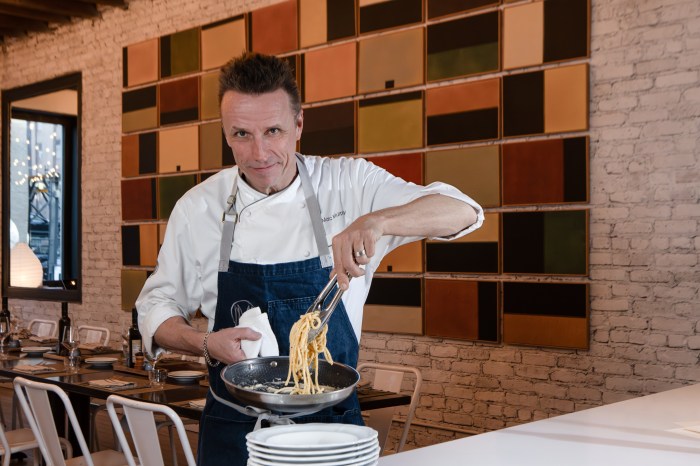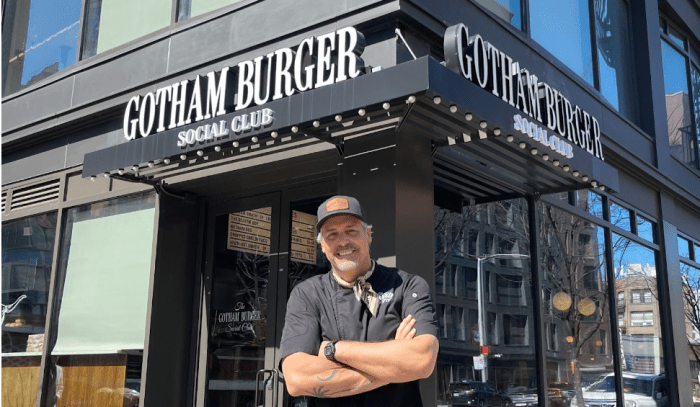A pair of softly lit tables stretches the length of the entry room of Dina Manganaris’ garden apartment in Harlem. Traditional Bosnian music welcomes her guests as she worked at the kitchen peninsula, putting the finishing touches on her homemade pastry. She serves the bread — a salty, flaky cross between a baguette and croissant that combines the recipes of two of her childhood favorites from Bosnia — with kajmak, a creamy hand-crafted cheese Manganaris makes by boiling milk over and over and over again until she has enough to serve.
“Bosnian cuisine is cuisine that is really slow cooked food,” Manganaris, 33, tells the group. Most of the evening’s dishes have been cooked for five or six hours over a low flame.
“Thank you for your time,” one of her guests shouts as they dig in. The strangers toast between bites with shared bottles of wine they brought with them. It’s the first of five courses.
Manganaris left Bosnia and Herzegovina more than a decade ago, but she never forgot the food and culture of her childhood there. About two years ago, a few years after she settled in New York, Manganaris signed up for EatWith, an online platform that connects diners with home cooks for dinner parties or cooking classes. She now hosts a bimonthly dinner out of her apartment for $66.
“I wanted to get connected with my heritage on my level and this helped me do that in such a beautiful way,” said Manganaris. “I use recipes from my family, from my grandma.”
While the concept is established in places like Europe, it’s only recently starting to take off in New York City as locals and tourists alike search for a more authentic travel experience.
But the platform hasn’t been without hurdles.
“This is kind of the future of eating out and the future of travel: to get these really authentic experiences in someone’s house,” said Susan Kim, EatWith’s CEO. “For us, the challenge in the U.S. market is how do you generate demand for something they don’t even know they want.”
Manganaris is one of about 70 EatWith hosts in New York, which only accepts about 4 to 8 percent of hosts that apply, Kim said. But while bookings in cities like Rome and Paris are doubling month over month, she said, New York is experiencing a slower growth rate.
“When people are coming to the U.S. to visit, I don’t think necessarily food is a big draw,” Kim added.
In Europe, about 60 percent of EatWith customers tend to be tourists; but that is significantly flipped for New York (and other U.S. cities), where about 70 percent of those signing up are locals, she said.
“People live in this city because they love exploring the newest, coolest thing,” said Chelsea resident Ben Gillman, 25, who booked a seat at Manganaris’ table after hearing about the concept from a friend who attended another dinner.
More and more, travelers are itching to ditch the double decker tour buses and forgo chain restaurants to experience something authentic, often through the knowledge of locals (and local food). Maxine Daniels, 31, who owns I Bike Harlem tours, receives about 95 percent of her business through Airbnb, which launched its “experiences” platform in Harlem in March. Daniels, who also works for the New York Stock Exchange, ends her tours through the neighborhood with a stop for soul food — but not at any old “touristy” spots, she said.
Guests circle central Harlem and see the George Washington Bridge and Alexander Hamilton’s house before settling down for some fried chicken and collard greens on the buffet at Jacob’s Restaurant.
“They see the whole spread, they’re floored, eyes pop out of their head,” she said. “People walk away with a totally different outlook on Harlem — not from a tourists’ perspective, from a locals’ perspective, which is great. It’s definitely better to go with a local because of the authenticity.”
EatWith host Laura Rucker, who holds dinners monthly in her studio apartment in Ditmas Park, said she tries to finish most of the cooking ahead of time so she can sit with her guests and get to know them.
“Every dinner we do there’s a handful of people from New York, there’s always a handful of people [from] overseas, and also a couple of people from my neighborhood,” said Rucker, 33. “By the end of the evening, everyone is exchanging phone numbers and emails. It’s kind of magical.”
Rucker, a full-time interior designer, started hosting dinners about a year ago. She charges $57 per meal and tends to favor Mediterranean-inspired menus, such as chicken tagine or carrots with feta and mint.
“For me, I kind of look it as a self-sustaining hobby,” she said. “I love getting to know everyone and meeting everyone; it’s also the social part of it, too.”
At Manganaris’ dinner one recent Saturday night, the guests were all first-time EatWith-ers: one group from the New York area, one from Tokyo and one from Canada.
Jackie Busheikin, 61 of Calgary, first heard about EatWith last year when she was booking another trip but didn’t pursue it. When she came to New York with her family, Busheikin rediscovered the concept on TripAdvisor (EatWith has a partnership with the reviews site).
“I also like the idea of community,” she said. “That it was more than just us, but intimate enough, you knew that you were going to meet people and talk to people, which you wouldn’t necessarily do in a restaurant.”
Sixty-year-old Toronto resident Jeff Cipin came with Busheikin, and said he was immediately excited to sign up for the dinner.
“Once you’ve gotten to our age, you’ve done enough fine dining that I think for me the experience is now what we’re looking for as much as the food,” he said. “This is going to be different, and if the food is really good, it’s a bonus.”

















